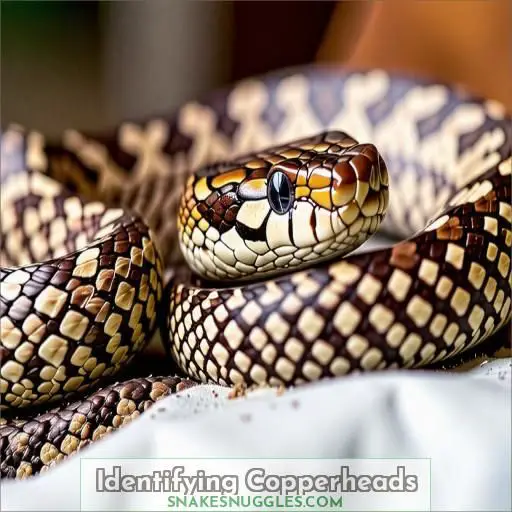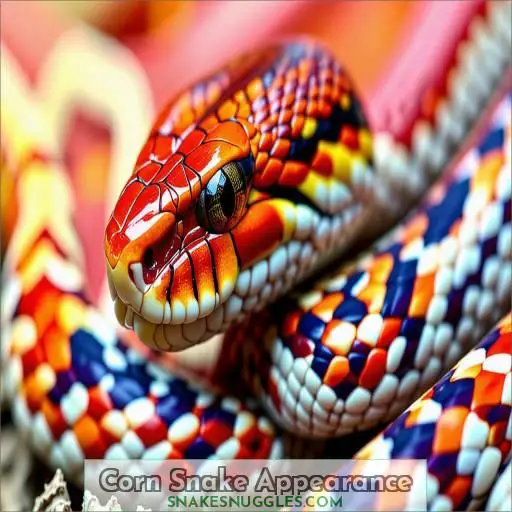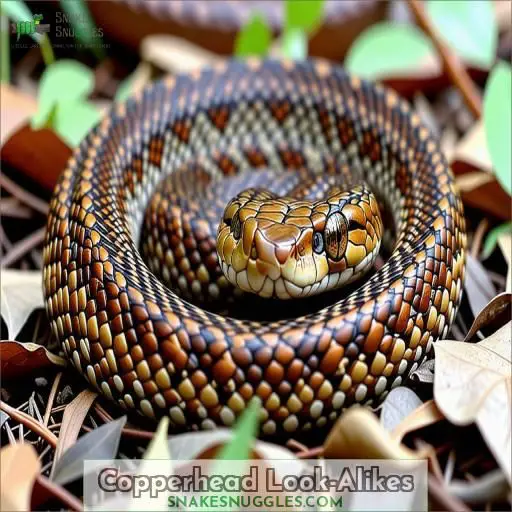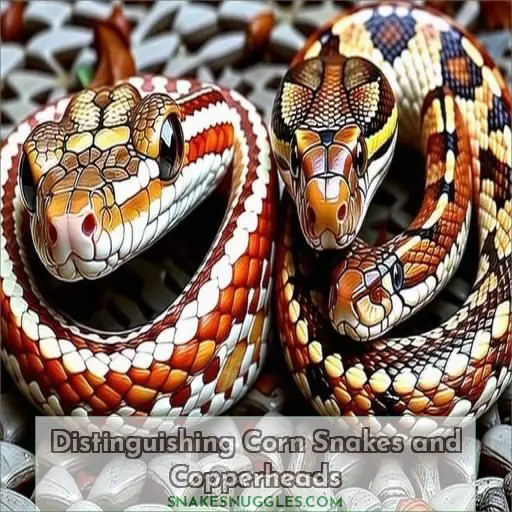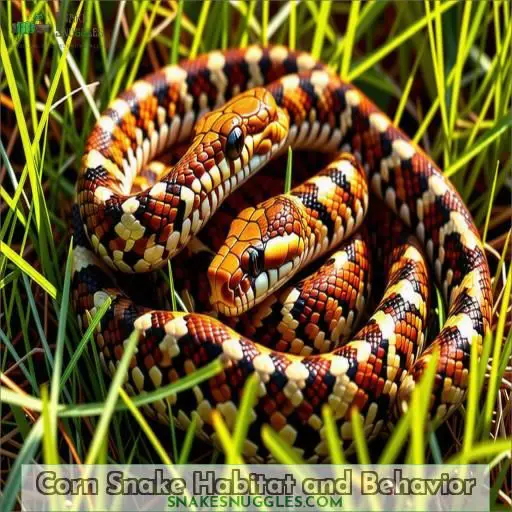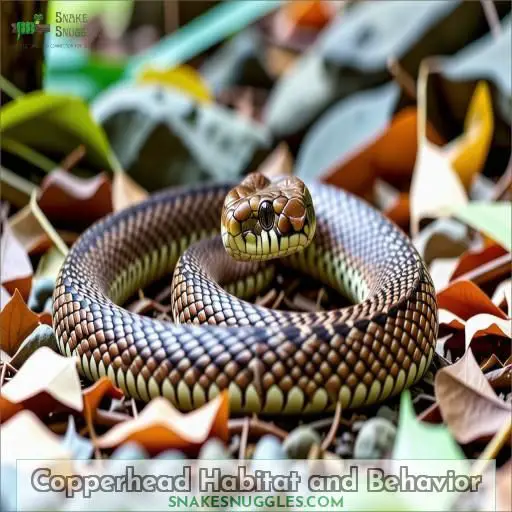This site is supported by our readers. We may earn a commission, at no cost to you, if you purchase through links.
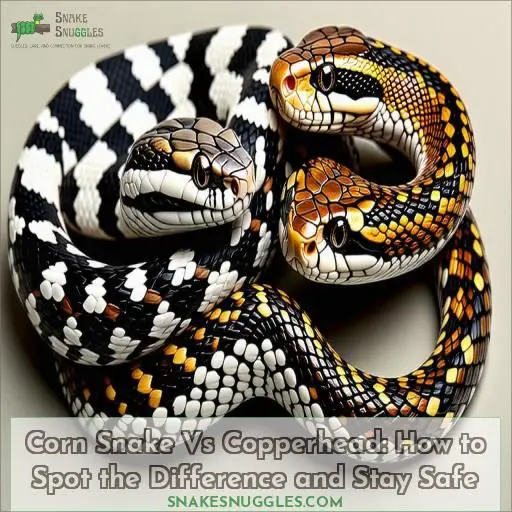 When encountering a snake in the eastern or central U.S., you’ll want to quickly distinguish the harmless corn snake from the venomous copperhead.
When encountering a snake in the eastern or central U.S., you’ll want to quickly distinguish the harmless corn snake from the venomous copperhead.
Corn snakes have round pupils and reddish-orange blotches, while copperheads boast hourglass-shaped crossbands and vertical, cat-like pupils.
Another key difference? Corn snakes lack heat-sensing pits that copperheads use to detect prey.
Though similar in pattern, checking the pupils and underside scales (double row for corn snakes, single for copperheads) can help you steer clear of an unwanted bite.
Stay vigilant, and you’ll learn to coexist safely with these fascinating reptiles.
Table Of Contents
- Key Takeaways
- Identifying Copperheads
- Corn Snake Appearance
- Copperhead Look-Alikes
- Distinguishing Corn Snakes and Copperheads
- Corn Snake Habitat and Behavior
- Copperhead Habitat and Behavior
- Safety Precautions
- Frequently Asked Questions (FAQs)
- How to tell if it’s a copperhead or corn snake?
- What snake is mistaken for a corn snake?
- What snake is mistaken for a copperhead?
- How do you tell if a snake is a corn snake?
- How can one distinguish copperheads from other non-venomous snakes?
- Are there any look-alikes to copperheads one should be aware of?
- What are the key differences between corn snakes and copperheads?
- What safety precautions are recommended when encountering copperheads?
- What are the unique features found in corn snake habitats and behavior?
- Conclusion
Key Takeaways
- Corn snakes have round pupils, reddish-orange blotches, and lack heat-sensing pits, while copperheads have vertical pupils, hourglass-shaped crossbands, and heat-sensing pits between their eyes and nostrils.
- Corn snakes have a double row of scales on the underside of their tails, while copperheads have a single row.
- Copperheads are found in wooded areas, rocky hillsides, and around streams, while corn snakes inhabit a variety of habitats including wooded areas and around human habitations, often preferring environments with proper snake care
.
- When encountering a snake, it’s important to maintain a safe distance, wear protective clothing, and seek immediate medical attention if bitten by a venomous snake.
Identifying Copperheads
When identifying a copperhead snake, look for its distinct hourglass-shaped crossbands along its body and vertical pupils with heat-sensing pits between the eyes and nostrils. Another key feature is the single row of scales on the underside of the copperhead’s tail, setting it apart from other snake species.
Hourglass-shaped Crossbands
Copperheads are identifiable by their distinctive hourglass patterns on the back, known as crossbands, characterized by their dark coloration and resemblance to the shape of a Hershey Kiss.
These lateral patterns are a key feature in differentiating copperheads from non-venomous snakes.
Understanding the geographic range of copperheads and their heat-sensing pit organs (Snake Safety Tips and Behavior) is essential in identifying the potential presence of these venomous snakes.
Vertical Pupils
Vertical pupils are a key identifying feature of copperheads. Unlike harmless corn snakes with round pupils, copperheads have slit-like pupils that resemble a cat’s eye. This ocular characteristic, along with the hourglass-shaped crossbands, helps distinguish copperheads from their lookalikes. Pay close attention to a snake’s pupil shape when attempting identification in the field.
- Vertical pupils indicate a venomous snake
- Round pupils are found in non-venomous snakes
- Pupil shape is a reliable identification tool
- Slit pupils allow for better low-light vision
- Ocular characteristics are key snake ID features
Heat-sensing Pits
Copperheads have a unique heat-sensing pit located between each eye and nostril (Source). These pits help snakes detect infrared radiation from warm-blooded prey . Corn snakes lack these pits (Source). The table below compares key differences between corn snakes and copperheads:
| Feature | Corn Snake | Copperhead |
|---|---|---|
| Pits | No | Yes |
| Pupils | Round | Vertical |
| Pattern | Blotched | Hourglass |
Carefully observe these features to distinguish between harmless corn snakes and potentially dangerous copperheads .
Single Row of Scales on Underside of Tail
The single row of scales on the underside of the tail is a distinctive feature of the Eastern Copperhead, aiding in its identification.
This anatomical characteristic sets it apart from other snakes like the Eastern Ratsnake and Northern Black Racer, which don’t possess this trait.
Understanding this key distinction is imperative for snake conservation efforts and ensuring safety when encountering these species.
Corn Snake Appearance
Unlike copperheads, corn snakes have a blotched pattern rather than hourglass-shaped crossbands, round pupils instead of vertical slits, no heat-sensing pits, and a double row of scales on the underside of their tails. Identifying these key differences can help you distinguish between the harmless corn snake and its venomous lookalike, the copperhead.
Blotched Pattern
Corn snakes have a distinctive blotched pattern that can be confused with several non-venomous look-alikes. Their pattern consists of:
- Reddish-orange blotches on a gray background
- Blotches that are wider on the sides and narrower on the back
- Blotches that are outlined in black
- A pattern that remains consistent throughout their life
This blotched pattern is shared by milksnakes, hog-nosed snakes, and certain watersnakes, making accurate identification critical for safety.
Round Pupils
Corn snakes have round pupils, unlike the vertical slit pupils of venomous copperheads and cottonmouths. This distinct pupil shape is a key distinguishing feature between harmless corn snakes and their venomous lookalikes. Round pupils are a reliable indicator that a snake is non-venomous, helping differentiate corn snakes from red cornsnakes, plain-bellied watersnakes, and common watersnakes that may share similar patterns.
No Heat-sensing Pits
Unlike copperheads, corn snakes lack heat-sensing pits between their eyes and nostrils.
Instead, they rely on their keen eyesight and round pupils to navigate their environment.
Corn snakes’ blotched patterns, round pupils, and double row of scales on their undersides help distinguish them from the venomous copperhead.
This key difference allows corn snakes to safely control rodent populations without posing a threat to humans.
Double Row of Scales on Underside of Tail
Juvenile corn snakes have a double row of scales on the underside of their tails, unlike copperheads which have a single row. This scale pattern, along with their blotched patterns and round pupils, helps distinguish corn snakes from venomous copperheads. Corn snakes are nonvenomous and play an important role in rodent control in their forest and woodland habitats.
Copperhead Look-Alikes
Several harmless snake species, including the Eastern Ratsnake, Northern Black Racer, Northern Watersnake, Eastern Milksnake, and Eastern Hog-nosed Snake, can be easily confused with the venomous Copperhead due to their similar patterns and colorations. It’s imperative to carefully examine key identifying features, such as hourglass-shaped crossbands, vertical pupils, and heat-sensing pits, to accurately distinguish Copperheads from their non-venomous look-alikes.
Eastern Ratsnake
The juvenile eastern ratsnake, also known as the black rat snake, starts with a gray or brown blotched pattern on a pale gray background . As it matures, this distinctive pattern fades to a uniform black color within about two years . Despite the drastic change in appearance, the ratsnake remains non-venomous and beneficial for controlling rodent populations .
Northern Black Racer
The Northern Black Racer is another snake that can be mistaken for a copperhead. As a juvenile, it has a blotched pattern that fades to uniform black within two years . Black racers are fast, active snakes that aren’t venomous. They’re known for their bold nature and tendency to stand their ground when threatened .
Northern Watersnake
The Northern Watersnake‘s juvenile pattern varies from dark grayish to reddish brown, with a narrow pattern on the sides and wide near the backbone . This coloration helps them blend into their watery habitat. While they may resemble copperheads, watersnakes are non-venomous and play an essential role in controlling rodent populations near streams and ponds.
Eastern Milksnake
The Eastern Milksnake‘s pattern varies greatly in color intensity, from bright red to pale gray. Found across the eastern US, they play a key role in rodent control. While not venomous, their striking resemblance to copperheads makes them a look-alike to watch for. Milksnakes are protected in some states due to declining populations .
Eastern Hog-nosed Snake
The Eastern Hog-nosed Snake, a close look-alike of the Copperhead, employs mimicry by playing dead, making it appear venomous but in reality, it’s harmless . It thrives in temperate habitats, preying on rodents, contributing to the ecosystem. However, it faces conservation threats . When encountered, caution is advised due to its mimicry abilities, emphasizing the need for proper identification.
Distinguishing Corn Snakes and Copperheads
While corn snakes and copperheads share similar blotched patterns, there are several key differences to look for when distinguishing between the two.
Corn snakes lack the heat-sensing pits found between the eyes and nostrils of copperheads.
Additionally, corn snakes have round pupils, while copperheads have vertical, cat-like pupils.
Corn snakes also have a double row of scales on the underside of their tail, compared to the single row found on copperheads.
Habitat preferences can also help differentiate the two species, as corn snakes are often found in wooded areas and around human habitations, while copperheads prefer rocky hillsides and stream banks.
Corn Snake Habitat and Behavior
Corn snakes are fascinating creatures found throughout the southeastern United States, with a range extending from New Jersey to the Florida Keys . These slender, orange or brownish-yellow snakes with distinctive black-outlined red blotches make excellent pets due to their docile nature and ease of care . Corn snakes typically inhabit wooded groves, rocky hillsides, meadowlands, and even abandoned buildings . Their diet consists primarily of rodents, which they hunt using their keen sense of smell . An adult corn snake can reach up to 5 feet in length and live for over 20 years in captivity with proper care . If you encounter a corn snake in the wild, simply observe from a safe distance and allow it to go on its way.
| Corn Snake Trait | Description |
|---|---|
| Diet | Rodents |
| Size | Up to 5 ft |
| Lifespan | 20+ years |
| Range | SE US |
| Habitat | Varied |
Copperhead Habitat and Behavior
Copperheads frequent wooded areas, rocky hillsides, and the vicinity of streams, preferring secluded habitats. They’re non-aggressive snakes, only striking if threatened or stepped on accidentally; their primary defense is to remain concealed and avoid confrontation with humans.
Found in Wooded Areas, Rocky Hillsides, and Around Streams
Copperheads inhabit wooded areas, rocky hillsides, and streams. They seek shelter in rock crevices and under leaves during hibernation, typically from late fall to early spring. The average lifespan of a copperhead is around 18 years. Their diet consists mainly of rodents, with occasional birds, insects, and amphibians. Mating occurs in late spring or early fall, with females giving birth to live young in late summer or early fall.
- Seek shelter in rock crevices and under leaves during hibernation
- Average lifespan of 18 years
- Diet consists primarily of rodents, supplemented with birds, insects, and amphibians
- Mating occurs in late spring or early fall
- Females give birth to live young in late summer or early fall
Avoid Human Contact and Only Bite if Threatened
When encountering a copperhead, it’s important to note that these snakes typically avoid human contact and will only bite if threatened.
Identifying their presence and maintaining a safe distance is essential for prevention.
Understanding their habitat and behavior, like their preference for wooded areas, rocky hillsides, and streams, helps in taking appropriate safety precautions.
Recognizing their behavior aids in avoiding potentially dangerous encounters in their natural habitat.
Safety Precautions
You should always wear long pants and boots when venturing into areas known for copperhead snake activity to protect your legs and ankles. If you’re bitten by a venomous snake, remain calm, remove any restrictive clothing or jewelry from the affected area, and immediately call emergency services or seek medical attention.
Wear Long Pants and Boots When in Copperhead Country
When venturing into copperhead country, protect yourself by wearing long pants tucked into boots. Avoid wearing sandals or open-toed shoes. Stay on marked trails and watch where you place your hands and feet. Be extra cautious when moving rocks, logs, or leaf litter. Staying alert and taking basic safety precautions can prevent snake bites during outdoor activities (Source).
Call Emergency Services if Bitten by a Venomous Snake
If bitten by a venomous snake, remain calm and call emergency services immediately. Seek prompt medical attention, as antivenoms are available to treat bites. Avoid applying ice, using tourniquets, or making incisions, as these can cause further harm. Remain still to slow venom absorption while waiting for emergency responders. Prompt treatment is critical for a successful recovery.
Never Attempt to Capture or Kill a Venomous Snake
Never attempt to capture or kill a venomous snake, as this is extremely dangerous and illegal in most areas. If bitten, call emergency services immediately and remain calm. Snakes only strike in self-defense, so give them space and they’ll leave you alone. Enjoy observing them from a safe distance and appreciate their essential role in the ecosystem.
Frequently Asked Questions (FAQs)
How to tell if it’s a copperhead or corn snake?
Look for the copper-red coloring and hourglass patterning on copperheads vs. corn snakes’ brighter red-orange hues. Copperheads also have heat-sensing pits and vertical pupils – key identifiers you should learn.
What snake is mistaken for a corn snake?
The copperhead snake is often confused with the eastern rat snake and northern water snake, which share similar patterns but lack the copperhead’s hourglass markings and heat-sensing pits.
What snake is mistaken for a copperhead?
You might mistake an Eastern Ratsnake or Northern Watersnake for a Copperhead. Their juvenile patterns resemble the Copperhead’s hourglass crossbands. Carefully observe details like head shape and eye pupils when identifying venomous snakes.
How do you tell if a snake is a corn snake?
As night falls, peer closely at its smooth head shape, lacking heat-sensing pits. Red-orange hues and candy corn saddles adorning its slender body signal a harmless corn snake.
How can one distinguish copperheads from other non-venomous snakes?
Look for vertical pupils, heat-sensing pits, and hourglass bands to identify copperheads. Key differences from harmless lookalikes include patterns, head shape, and scale arrangements.
Are there any look-alikes to copperheads one should be aware of?
True, there are a few lookalikes that can easily be confused. Eastern ratsnakes, black racers, and even some watersnakes share similar patterns to copperheads, so you’ll need to look closely at key details to properly identify them.
What are the key differences between corn snakes and copperheads?
You can distinguish copperheads from corn snakes by their hourglass patterns and sulfur-yellow tail tips. Corn snakes lack these distinct markings.
What safety precautions are recommended when encountering copperheads?
Like a coiled spring, stay alert – if a copperhead’s nearby, keep your distance and don’t provoke it. Wear thick pants, closed-toe shoes, and use a flashlight at night. Should you get bitten, remain calm and call emergency services immediately.
What are the unique features found in corn snake habitats and behavior?
Corn snakes prefer wooded areas with abundant hiding spots for their active rodent-hunting. They’re non-venomous, shy constrictors recognizable by their bright red-orange saddle patterns.
Conclusion
Like encountering a fork in the road, distinguishing a corn snake from a copperhead requires careful observation.
With vigilance and knowledge of their distinct physical traits – round pupils, heat-sensing pits, and scale patterns – you can safely coexist with these reptiles.
Stay alert, respect their space, and if bitten by a venomous copperhead, seek immediate medical attention.

